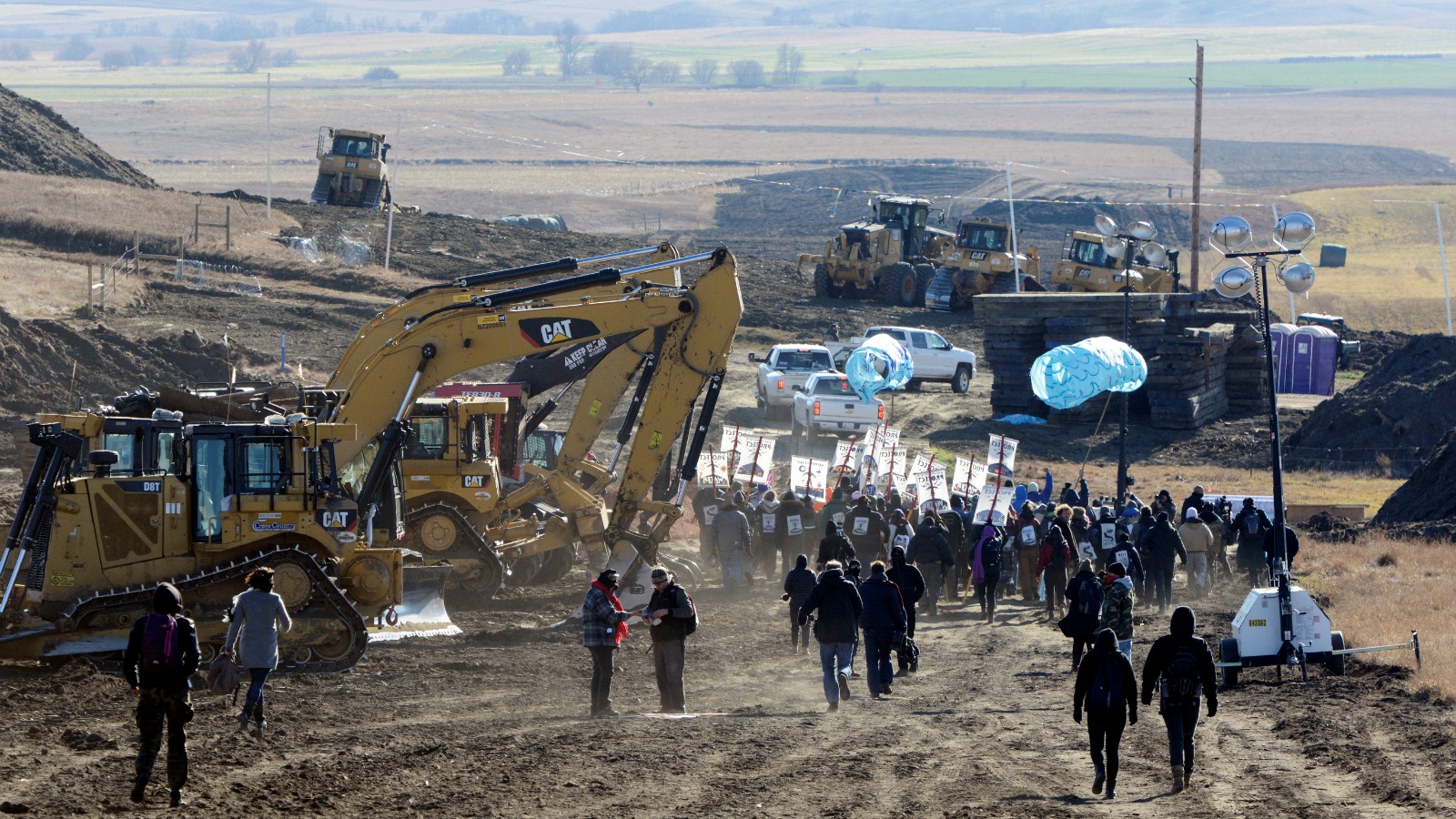This story was originally published by High Country News and is reproduced here as part of the Climate Desk collaboration.
As the weather gets colder, the fight over the Dakota Access Pipeline is heating up, in rather ugly ways. Just days before Thanksgiving, law enforcement officers tried to blast the protesters away with water cannons in 25-degree weather and employed other “less than lethal,” though still harmful, dispersal methods. One protester may lose her arm as a result of injuries suffered during the violence. And to top it off, the Army Corps of Engineers plans to close one of the camps of “water protectors” next week, which may embolden law enforcement to take a more forceful approach.
High Country News has reported what’s at stake for the Standing Rock Sioux tribal members and their allies trying to stop or reroute the project: tribal sovereignty, water, environmental justice, holy lands, treaty rights, and antiquities. Add to that the prospect of more carbon spewing into the atmosphere, and one can see why activists are risking so much to stand in the pipeline’s way.
Less clear is what the $3.78 billion, 1,172-mile-long crude oil pipeline offers in return if and when construction is completed and it goes into operation. Energy Transfer Partners, the project’s main proponent, says that the pipeline will offer jobs, economic relief to a struggling region, and, by spurring production of North Dakota crude, it will take the U.S. closer to the lofty ideal of energy independence.
Construction on the pipeline is about 85 percent complete and it has, indeed, put people to work. Yet it is not clear how many new jobs have been created since the jobs are spread out over 1,000 miles. Rural towns along the pipeline’s corridor have reported a boost in hotel and campground occupancy rates as the contractors move through. That, in turn, generates sales and lodging tax revenues for the local governments. The boost, however, won’t last. In a few months, when (and if) construction is complete, the workers and their spending money will depart. The finished pipeline will require just 40 permanent maintenance and operational jobs along its entire stretch.
Once oil is flowing, property tax revenues — an estimated total of $55 million annually — will kick in. While it’s a big chunk of change, the impacts will be diffused, shared by four states. North and South Dakota are expected to receive about $13 million each, divided between several counties, a drop in the budget bucket (Colorado generates nearly $20 million per month from taxes and fees on marijuana). That said, it might be enough to buy the county sheriffs some more military gear from the Pentagon in order to squelch the next pipeline protest. It will not, however, cover the costs of such squelching: The current law enforcement effort has reportedly cost $15 million so far.
The fact is, pipelines, like transmission lines, don’t have a major economic impact except when they’re built. They otherwise go mostly unnoticed until they spill, burst, or explode.
The bigger-picture impact, whether on climate change or energy independence, is more difficult to suss out. Both proponents and opponents seem to be working on the “build-it-and-they’ll-fill-it” premise. That is, if you expand pipeline capacity for North Dakota crude, it will encourage more oil drilling and thus more oil production. If more domestic oil is produced, the logic goes, then we have less need to import foreign oil and we achieve greater energy independence. The flip side to that is, the more oil we drill, the more we consume, resulting in greater carbon emissions. It’s summed up in this nifty formula:
- More Pipeline Capacity —> More Oil Production —> More Energy Independence and Carbon Emissions
This formula, however, holds only if lack of pipeline capacity is a major hindrance to oil development. It’s not. We can move crude oil not only through pipelines, but also with trucks, trains, and tankers. Oil’s mobility (along with its relative fungibility) help make it a global commodity in a way that natural gas, for example, is not. The lack of pipeline capacity is not a major limiting factor in oil development and production; when the North Dakota boom was on, no one opted out of drilling because of lack of transportation options. In fact, prices were so high, no one opted out of drilling at all.
Just as the biggest driver of oil development is a high oil price, the biggest hindrance, particularly for expensive-to-drill North Dakota crude, is a low oil price. That relationship has been on display in North Dakota, and across the West, for the last decade: Oil prices went up, thanks to burgeoning demand in China and the developing world, so drilling intensified and production went bananas. Oil prices crashed as China’s economic growth slowed, the drill rigs were stored away, and production has decreased.
Very few wells have been “shut-in” or plugged up. Most of the already-drilled wells continue to produce, but at lower and lower rates, a phenomenon known as the “decline curve.” Wells that produced 220 barrels per day when they were drilled in 2005, for example, now only produce about 20 barrels per day.
When these critical factors — global supply vs. demand and price — are put into the aforementioned formula, the outcome becomes far murkier. No longer does more pipeline capacity directly lead to more production; it must first either raise the price of oil, or induce demand. The latter’s not going to happen. A pipeline across the upper Midwest will not inspire the masses in China to buy cars and drive them all over the country. It will not affect global demand.
So how about price? The Dakota Access Pipeline is expected to carry half-a-million barrels of oil per day to refineries and market hubs in Illinois. Moving a barrel of oil on the pipeline is expected to cost about $8, compared to approximately $15 for shipping it via rail. That is, if the producer would have received $34 per barrel for rail-shipped oil, it will get $41 per barrel for Dakota Access Pipeline-shipped oil.
This $7-per-barrel bonus could add up to hundreds of thousands of dollars in additional revenue for the producer over the well’s life, and could certainly keep wells from being shut-in. Yet it’s doubtful that it’s enough to push the producer to dust off the rigs and start drilling again. It costs anywhere from $5 million to $15 million to drill a well in North Dakota’s Bakken formation. After the last bust, producers and their investors are unlikely to fork out that kind of cash until oil prices go up considerably and stay there, which will only happen if Saudi Arabia commits to a long-term slash in its production. Unless new wells are drilled in North Dakota at a furious rate, production will continue to decrease, thanks to the decline curve.
There is one other way the pipeline could impact oil prices, at least for the oil flowing through the line. Some oil customers reportedly entered into contracts with producers prior to construction to buy DAPL oil at or near 2014 prices. If those contracts remain in place despite the protest-caused construction delay, it could, theoretically, push producers to drill a few more wells to produce enough oil to fetch the higher price. But probably not. It’s more likely that those producers will simply divert oil now shipped by rail to the pipeline, thus increasing profit without increasing production.
If, somehow, the pipeline were able to increase oil production, then we’d still have another variable to plug into our equation. I’ll call it the T. Greg Merrion factor, for the New Mexico oil executive who told me about it: “Nothing helps low prices like low prices, and nothing hurts high prices like high prices.” That is, the increased supply delivered by the pipeline (without a consequent increase in demand) would increase the amount of oil supply on a market where demand can’t keep up with supply. The glut grows. Prices slide further downward. There’s even less drilling. Production slides. The cycle continues.
- The Dakota Access Pipeline, on its own, is not likely to result in increased production of North Dakota crude, because More Pipeline Capacity ≠ More Demand;
- Therefore, the pipeline will not create more oilfield jobs or result in higher severance tax revenues to North Dakota;
- If there is any uptick in production thanks to the pipeline, it won’t be enough to put a dent in the 5.2 million barrels of oil the U.S. continues to import each and every day;
- Since the pipeline won’t push more production, it also will not result in more consumption. Therefore, it will not directly lead to a significant increase in carbon emissions.
Which is to say, the pipeline will be neither the economic boon, nor the climate bane, it’s been made out to be. Nor will it get the U.S. any closer to energy independence.
Why, then, is Energy Transfer Partners so intent on building this thing? The equation that answers that one is far simpler. If the pipeline indeed carries 470,000 barrels per day, at a rate of $8 per barrel, the company should gross about $1.37 billion per year. Operating costs are low (remember, there are just 40 employees running this thing), so it shouldn’t take long to recoup the capital costs. That leaves a lot for the investors, like Energy Transfer Partners’ billionaire CEO Kelcy Warren or reputed billionaire and president-elect Donald Trump.
Yes, Trump is invested in the companies behind the pipeline, though the amount of his stake decreased substantially between 2015 and 2016. Meanwhile, Warren donated more than $100,000 to Trump’s campaign, clearly hoping he would remove federal obstacles to the pipeline.
These numbers are worth considering when you see the images of the “water protectors” getting pummeled with water cannons, rubber bullets, and tear gas. They’re not being attacked in the name of jobs, the economy, or energy independence. They’re being attacked in the name of profit.




